python实现TF-IDF算法解析
TF-IDF(term frequency–inverse document frequency)是一种用于信息检索与数据挖掘的常用加权技术。
同样,理论我这里不再赘述,因为和阮一峰大神早在2013年就将TF-IDF用一种非常通俗的方式讲解出来
材料
1.语料库(已分好词)
2.停用词表(哈工大停用词表)
3.python3.5
语料库的准备
这里使用的语料库是《人民日报》2015年1月16日至1月18日的发表的新闻。并且在进行TFIDF处理之前已经进行了人工分词(当然也可以使用jieba分词,但效果不好)
三天的新闻篇章数量如下:
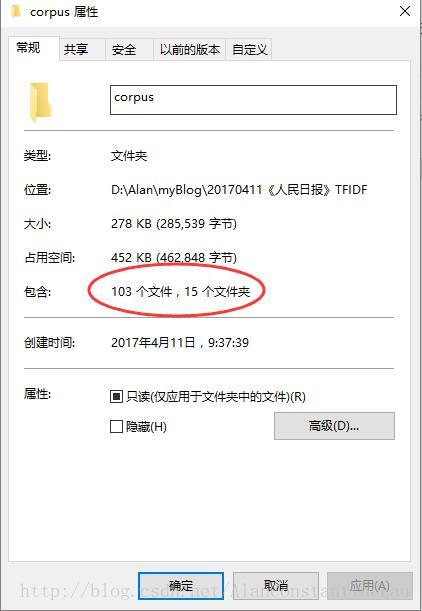
语料库中共103篇新闻。每篇新闻存入在txt文件中,编码为UTF-8无BOM
这里放一篇文章示例下:

我在自己的项目路径下新建一个corpus的文件夹,用于存放已经分好词待计算的语料。corpus文件夹的架构如下:
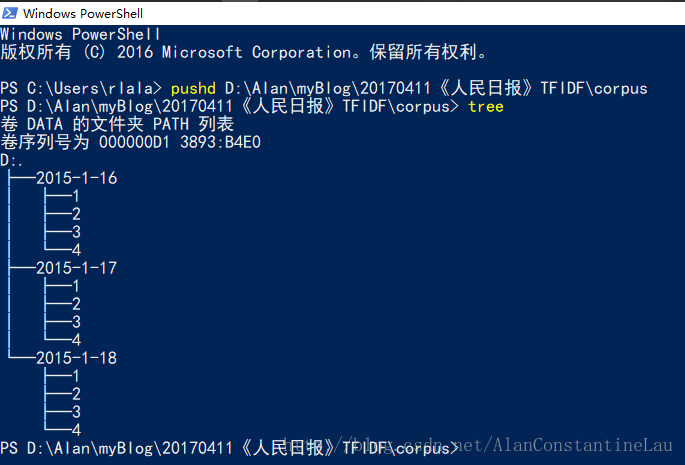
2015年1月16日至1月18日共三天,每天可获取的新闻分了四版,因此针对每一天下的每一版我又分别建了编号为1、2、3、4的文件夹,用于存放每一版的新闻。
其实也没必要这么麻烦,可以直接把所有的新闻都放到一个文件夹下,只是我个人的文件管理习惯。当然放到数据库里面更好。
关于停用词表
较好用的停用词表有哈工大停用词表、百度停用词表、川大停用词表,网上一查一大堆。我这里选择的是哈工大停用词表。
代码实现
# -*- coding: utf-8 -*-
# @Date : 2017-04-11 09:31:55
# @Author : Alan Lau (rlalan@outlook.com)
# @Language : Python3.5
import os
import codecs
import math
import operator
def fun(filepath): # 遍历文件夹中的所有文件,返回文件list
arr = []
for root, dirs, files in os.walk(filepath):
for fn in files:
arr.append(root+"\\"+fn)
return arr
def wry(txt, path): # 写入txt文件
f = codecs.open(path, 'a', 'utf8')
f.write(txt)
f.close()
return path
def read(path): # 读取txt文件,并返回list
f = open(path, encoding="utf8")
data = []
for line in f.readlines():
data.append(line)
return data
def toword(txtlis): # 将一片文章按照‘/'切割成词表,返回list
wordlist = []
alltxt = ''
for i in txtlis:
alltxt = alltxt+str(i)
ridenter = alltxt.replace('\n', '')
wordlist = ridenter.split('/')
return wordlist
def getstopword(path): # 获取停用词表
swlis = []
for i in read(path):
outsw = str(i).replace('\n', '')
swlis.append(outsw)
return swlis
def getridofsw(lis, swlist): # 去除文章中的停用词
afterswlis = []
for i in lis:
if str(i) in swlist:
continue
else:
afterswlis.append(str(i))
return afterswlis
def freqword(wordlis): # 统计词频,并返回字典
freword = {}
for i in wordlis:
if str(i) in freword:
count = freword[str(i)]
freword[str(i)] = count+1
else:
freword[str(i)] = 1
return freword
def corpus(filelist, swlist): # 建立语料库
alllist = []
for i in filelist:
afterswlis = getridofsw(toword(read(str(i))), swlist)
alllist.append(afterswlis)
return alllist
def wordinfilecount(word, corpuslist): # 查出包含该词的文档数
count = 0 # 计数器
for i in corpuslist:
for j in i:
if word in set(j): # 只要文档出现该词,这计数器加1,所以这里用集合
count = count+1
else:
continue
return count
def tf_idf(wordlis, filelist, corpuslist): # 计算TF-IDF,并返回字典
outdic = {}
tf = 0
idf = 0
dic = freqword(wordlis)
outlis = []
for i in set(wordlis):
tf = dic[str(i)]/len(wordlis) # 计算TF:某个词在文章中出现的次数/文章总词数
# 计算IDF:log(语料库的文档总数/(包含该词的文档数+1))
idf = math.log(len(filelist)/(wordinfilecount(str(i), corpuslist)+1))
tfidf = tf*idf # 计算TF-IDF
outdic[str(i)] = tfidf
orderdic = sorted(outdic.items(), key=operator.itemgetter(
1), reverse=True) # 给字典排序
return orderdic
def befwry(lis): # 写入预处理,将list转为string
outall = ''
for i in lis:
ech = str(i).replace("('", '').replace("',", '\t').replace(')', '')
outall = outall+'\t'+ech+'\n'
return outall
def main():
swpath = r'D:\Alan\myBlog\20170411《人民日报》TFIDF\code\哈工大停用词表.txt'#停用词表路径
swlist = getstopword(swpath) # 获取停用词表列表
filepath = r'D:\Alan\myBlog\20170411《人民日报》TFIDF\corpus'
filelist = fun(filepath) # 获取文件列表
wrypath = r'D:\Alan\myBlog\20170411《人民日报》TFIDF\result\TFIDF.txt'
corpuslist = corpus(filelist, swlist) # 建立语料库
outall = ''
for i in filelist:
afterswlis = getridofsw(toword(read(str(i))), swlist) # 获取每一篇已经去除停用的词表
tfidfdic = tf_idf(afterswlis, filelist, corpuslist) # 计算TF-IDF
titleary = str(i).split('\\')
title = str(titleary[-1]).replace('utf8.txt', '')
echout = title+'\n'+befwry(tfidfdic)
print(title+' is ok!')
outall = outall+echout
print(wry(outall, wrypath)+' is ok!')
if __name__ == '__main__':
main()
运行效果:
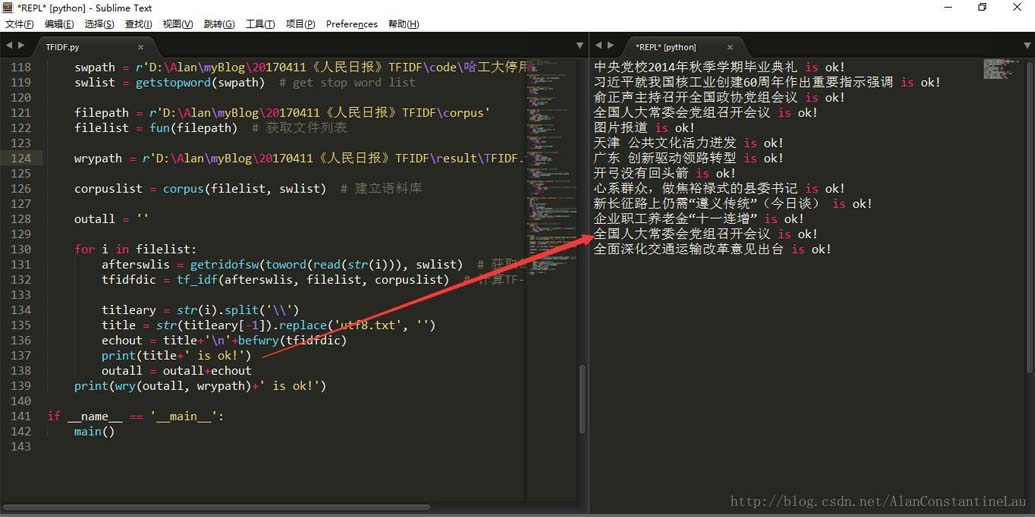
最终结果
这里放两篇新闻的TFIDF
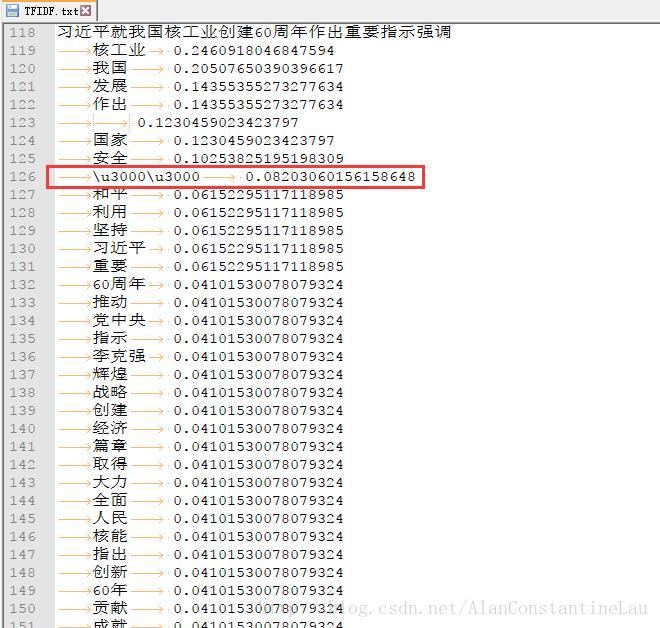
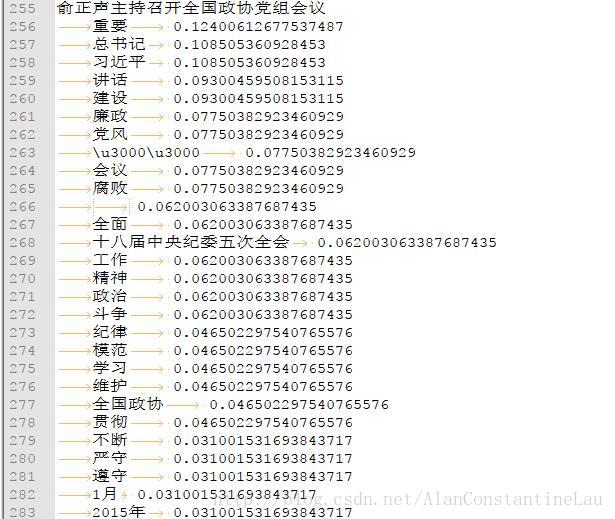
可以看到,第一篇新闻的关键词可以认为为:核工业、发展、安全
第二篇新闻:习近平总书记、廉政、党风
关于\u3000\u3000这个问题实在不知道怎么替换掉,各种方法使用过了,不知哪位大神看到恳请指点下。
以上就是本文的全部内容,希望对大家的学习有所帮助,也希望大家多多支持【听图阁-专注于Python设计】。
